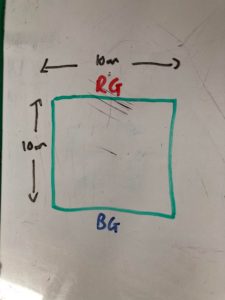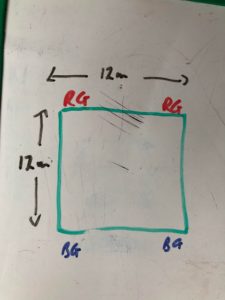Teams of all ages and grades have players of varying abilities and this is probably no more pronounced then in junior footy with the major problem for coaches being how to design training to fit all players.
This post will greatly help coaches navigate their way through this process, albeit a very multi-faceted one.
THE WHY'S OF JUNIOR FOOTBALL
In my opinion junior football has 3 why's that o above and beyond anything else:
1 - Participation
2 - Enjoyment
3 - Retention
These 3 why's will be at the forefront of this entire post.
I don't want to hear about a winning-at-all-costs attitude from any junior football coach.
MULTI-ABILITY
In pretty much every team you've got 3 levels of players - high, middle and low.
Once you've got your 3 levels sorted then it's a good idea to find out why those players are where they are.
The higher level players might have done 3 - 4 years of Auskick, and play a lot of footy/sport outside of training and games.
The middle level players might have missed a lot of Auskick, are relative late-comers to footy and/or play other sports.
The lower level players might be brand new to footy and don't really play any other sport at any other times of their life.
On top of this it's handy to know who of your players are born in the first half of the footy caleander year and who is born in the 2nd half of the footy calander as that is can render a relatively big difference in body and brain development.
I'd also find out why they play football in the first place.
As a club you could gather most of this information upon player registration at the start of each year.
Once you've got this information then you can start to think about what you can do for and with them.
GAMES v DRILLS
A drill is something you repeat looking for the perfect method or technique to do it in - a fire drill is getting a group of people to follow a map to a safe area with absolutely no room for deviation.
In football terms this is a cone-to-cone activity that follows a pre-determined path with a certain technique, most often not allowing any deviation - the complete opposite of a game of footy.
Footy is filled with decision making based off the play happening around you - nothing is pre-determined.
There is constantly opposition trying to stop you doing what you want to do - there's no free ride to a cone with a player on it you already know is going to be there.
I could go on for pages here but essentially drills-bad, games-good, and the quicker you can transition to using games at training the easier training will be for you to run, and the better experience and fun your players will have.
The best thin about games is that they are far easier to modify for multi-abilities then a cone-to-cone activity because if a lower level player can't really kick to a target then the coach feels the pressure from past coaching experiences to make the activity look clean which will never happen at junior level.
Plus your only giving the opportunity for players to practice 1 type of kick and for your middle and lower level players, it's probably not a kick they'll experience in a game situation anyway (no pressure to a target undefended).
These cone-to-cone activities really only serve a fraction of your playing group and is essentially only skill rehearsal, not skill development.
HOW GAMES CAN SERVE ALL PLAYERS
You can't modify cone-to-cone drills because you can't deviate within a drill, as mentioned above but games on the other hand are extremely flexible and are only limited by your abilities as a coach.
I'm going to use a simple handball game for example here.

2 teams with a goal to score in at each end- pretty simple but why are we using this game?
Handball is mostly used in congestion during a game so it makes sense that we are trying to break the congestion through handball to reach a teammate outside of the congestion who can have the time and space to kick.
So this game is dealing with breaking congestion only as we don't have any kicking in this game - this is called training a slice of the game, where 99% of coaches try and coach too many things at once and it descends into total chaos with zero teaching and thus, zero learning.
This next bit is where you can go to the next level but requires a little bit of extra support from either assistant coaches or parents that can assist.
Usually coaches would try and keep everyone together or maybe split the team in half so it's either 25 players or 12 players per activity.
The splitting in half is a good move but I'd go even smaller if you can.
3 groups means you can split into your 3 levels of players so each player is training a lot closer to their optimal challenge point.
All players together makes it too easy for the high players but too hard for the lower players leaving only the middle players receiving training to their ability, but are also dominated by the high players so don't really receive any benefit either.
You should be able to clearly see how this affects each and every player in regards to their development and enjoyment.
Smaller groups also allow for more total actions per player which allows your middle and lower level players to have the same amount of learning opportunities as your higher players do - the players that stand still on game day while the ball is 150m away definitely won't be standing still in a small sided game against players of the same ability, I guarantee it.
Getting back to our handball game that's working on clearing congestion via handball, the way you design the game can be done in line with fulfilling the challenge point for each of the 3 groups.
1 GAME, 3 LEVELS
For the higher level players, you can use the design from above - 1 goal/team at each end in a relative condensed area of about 10x10m but feel free to play with dimensions a little if needed.
With cleaner hands and better decision making, players will more then likely use most of the area, fully utilising the space they have to use, and finding ways to manipulate the lack of, or surplus of space they fond themselves in.
For the middle level players where the skills aren't as clean and the ball possibly not moving around as freely as the higher group, you've got 2 options.
The first option is to open up the space some more (maybe 12x12m - it won't need to be much) or alter the placement of the goals as in below:

All we've done is added goals to each corner for 1 team which will spread them out in the game, and then the defending team at that end will also hopefully spread out as well to defend against it.
This teaches players not just to follow the ball around like under 8's and also to be aware of the opposition and the space they have to work in but most importantly, by spreading the players a tad, it gives more time to be clean with the ball - fitting with their optimal challenge point nicely.
I'd alter goal positioning over playing area 9 times out of 10 for the middle group, only increasing the playing area if absolutely necessary but hopefully guiding the players through that instead.
Obviously play 1 half of the game to the 2 goal and then switch ends.
For the lower level group we'll again alter the goals like this while also altering the playing area slightly:

Making both alterations serves these players greatly as they need less congestion and more time to execute skills and make decisions.
Placing on goals on each side makes the game horizontal which teaches them to look elsewhere but straight in front - there's no way to score by looking directly in front so they are forced to look, and players out of possession to move, into free space that is developed entirely by how you've created the activity and wholla - explicit learning!
PLAYER NUMBERS
The lower level the players, the less player numbers you should look to use in those games.
We want those players to potentially have more game actions then the higher level players who are already advanced enough to find adequate game actions in pretty much any game.
For the lower level game you're looking at anything from 3v3 to 5v5.
For the middle game you can up to 4v4 to 5v5 and for the higher level game you can push a little harder and go from 4v4 for high work rate to 6v6 for high decision making.
The rules are the same for all games being full football rules with tackling, bumping etc of which most dads should be able to handle and because you've set the game up to be self-teaching, you don't have to coach everyone at the same time.
If you have 3 dad's that can umpire then you can do what a coach is supposed to do and observe and then ask questions to the players based on what you're seeing.
I'm gonna pull up here before this gets out of hand but hopefully you can see how games are where it's at and how you can design them to fit the 3 levels of players within your team which will have them all participating more standing around behind cones, they''' be involved in far more game actions then ever before and giving them the opportunity to develop their skills equaling far more enjoyment and then hopefully all of these positive experiences early in their football won't result in the huge drop our rates once they hit their teenage years of which we as coaches (and football clubs) have total control over, contrary to popular belief.
Any questions, and there should be, leave a comment or hit me up.


No comments:
Post a Comment